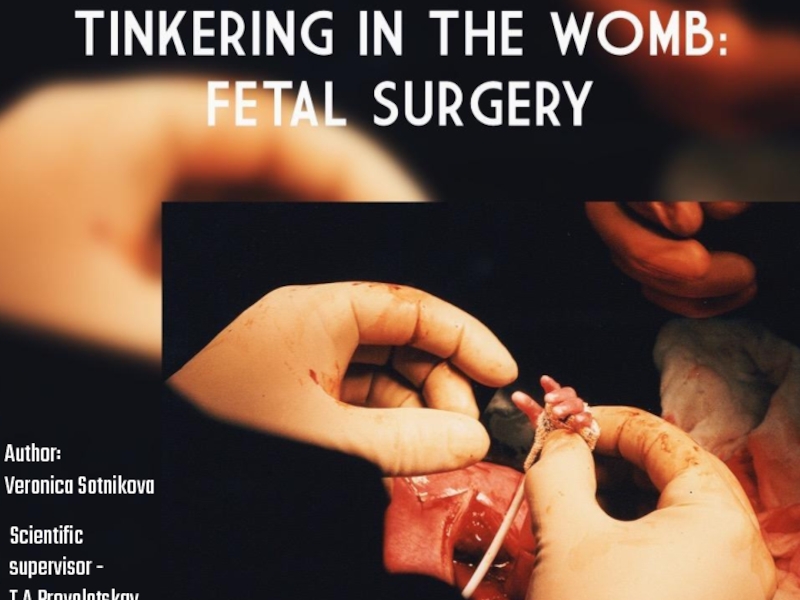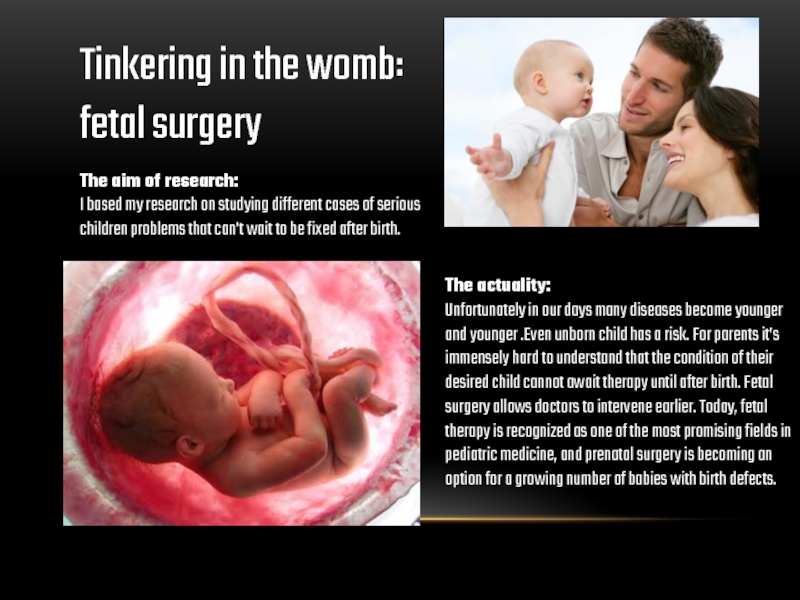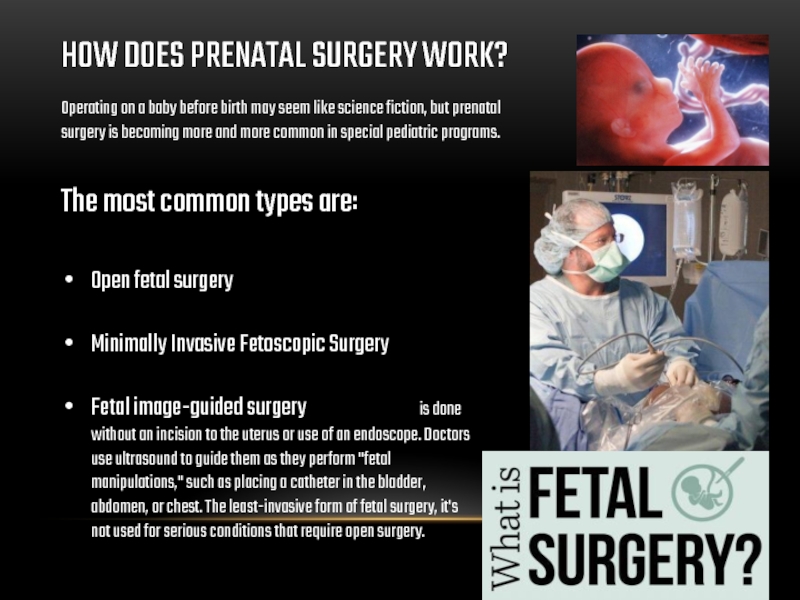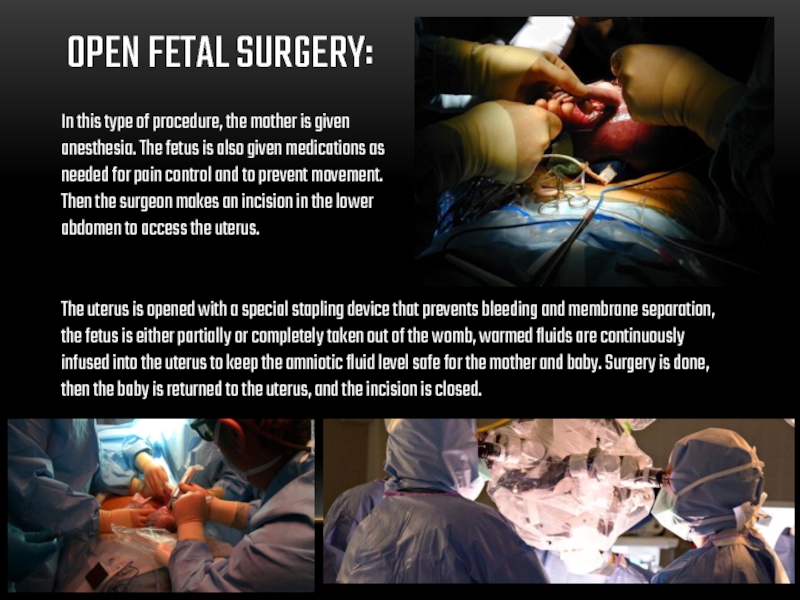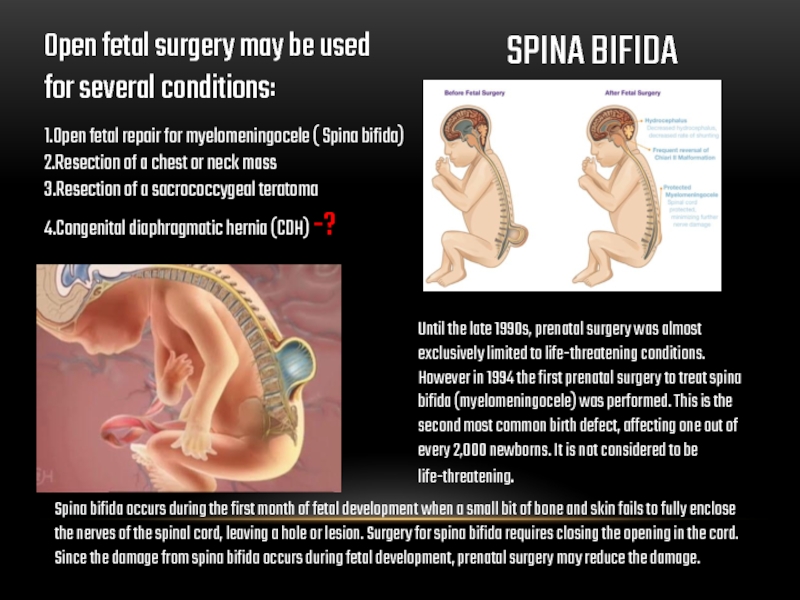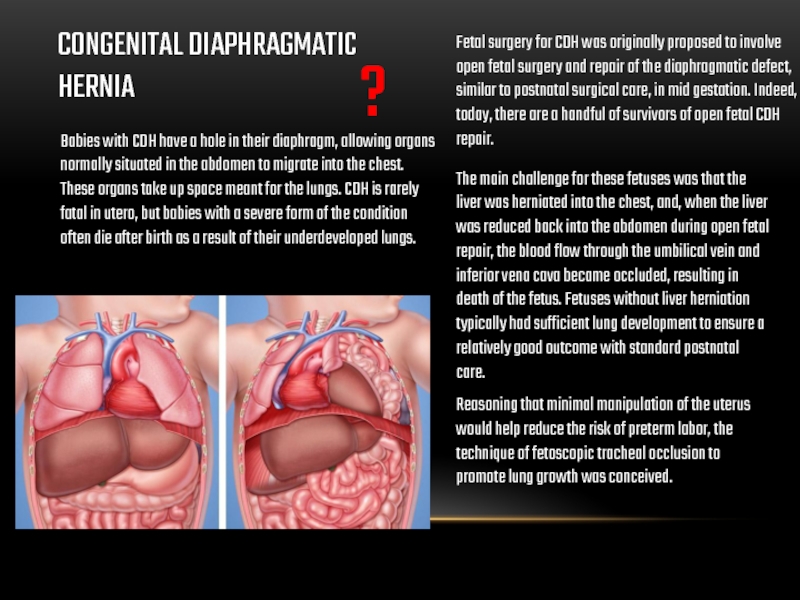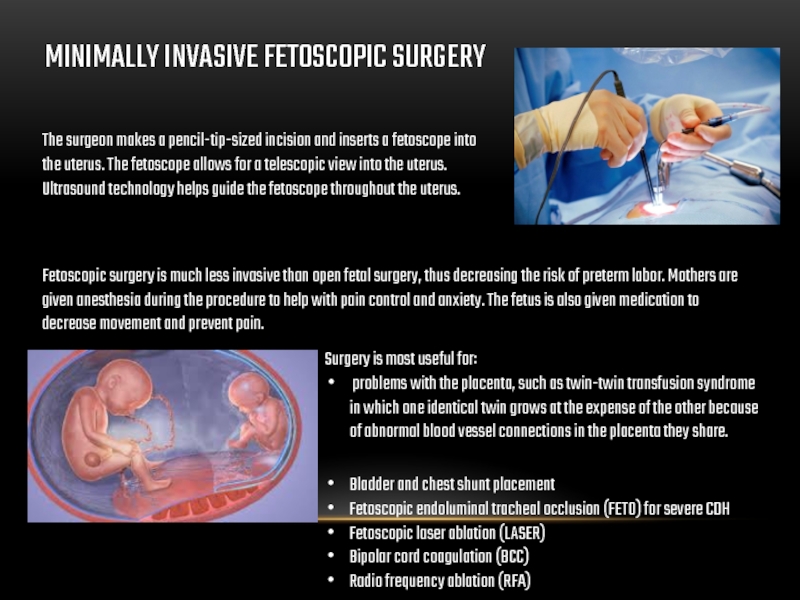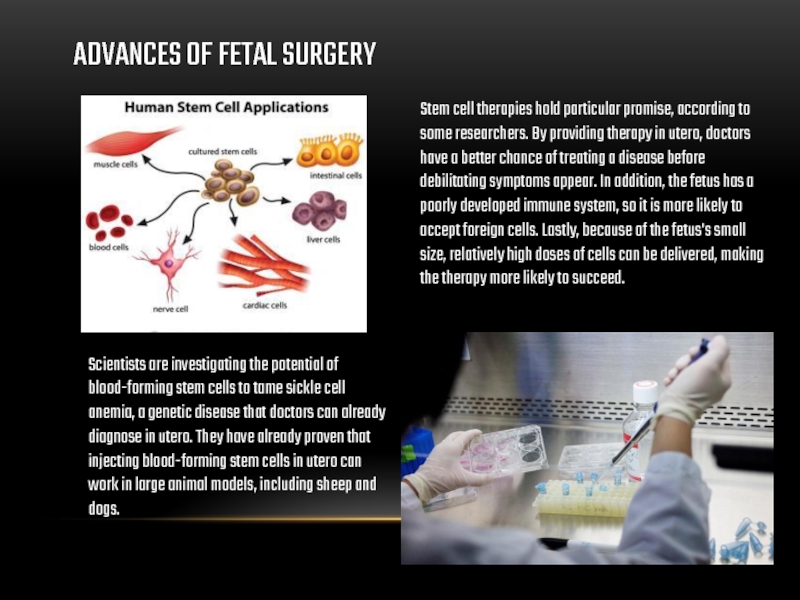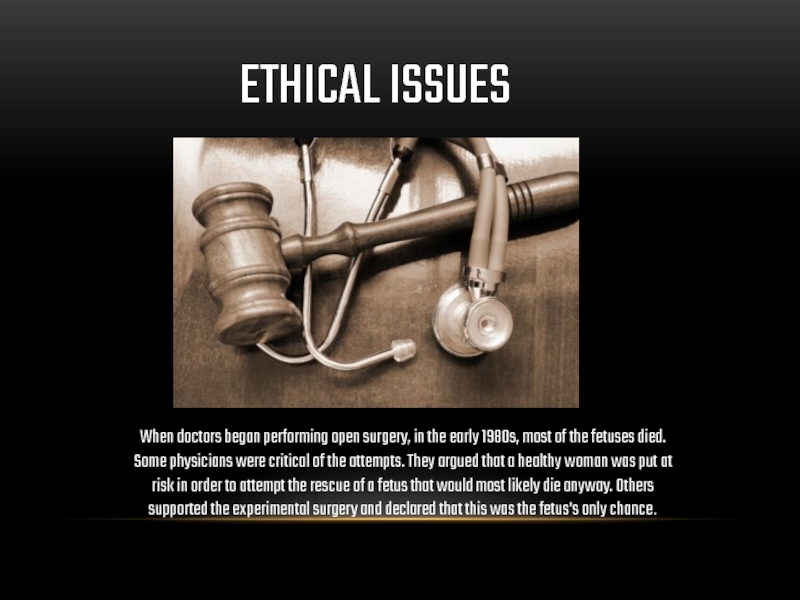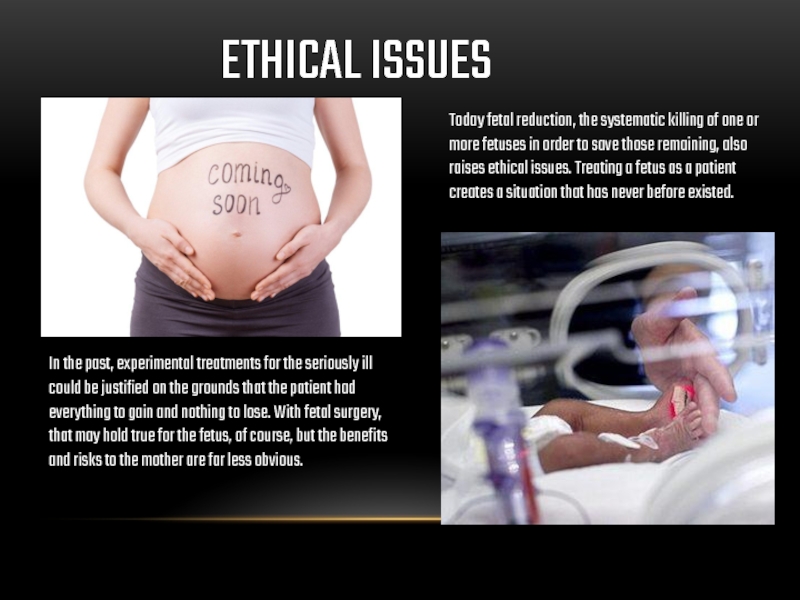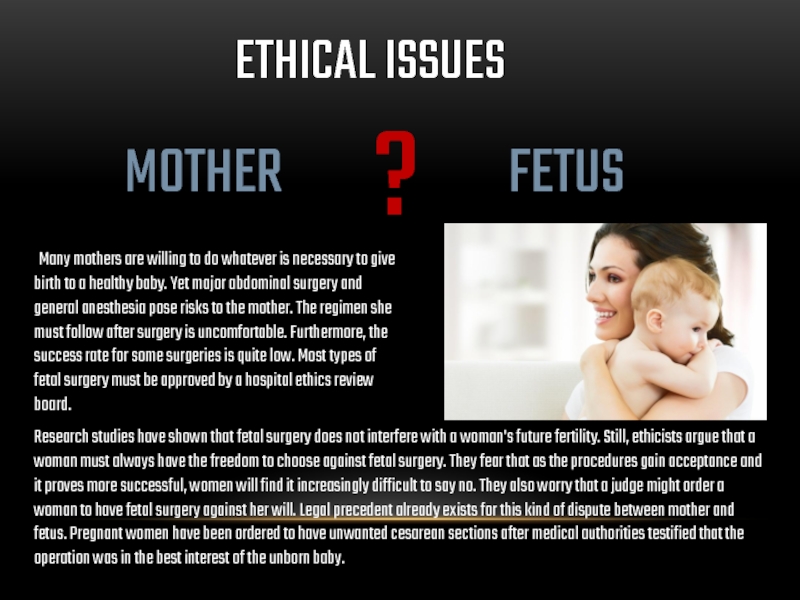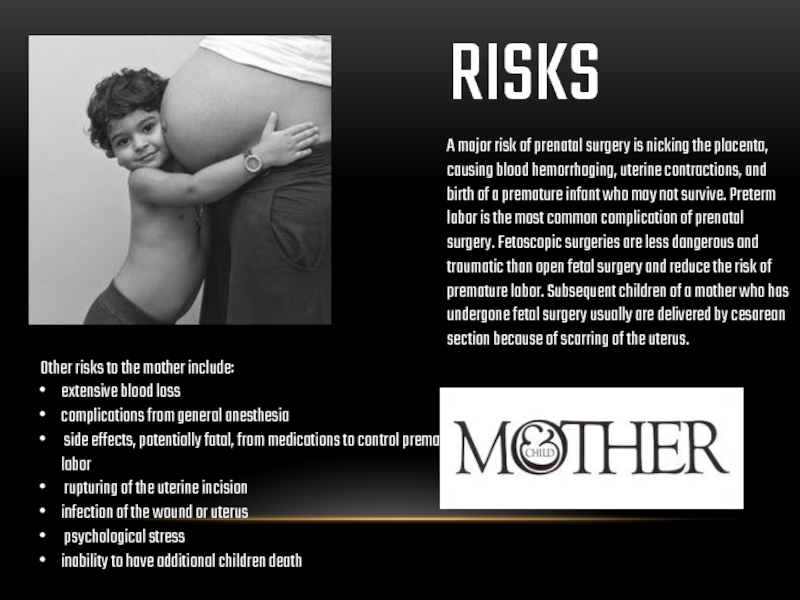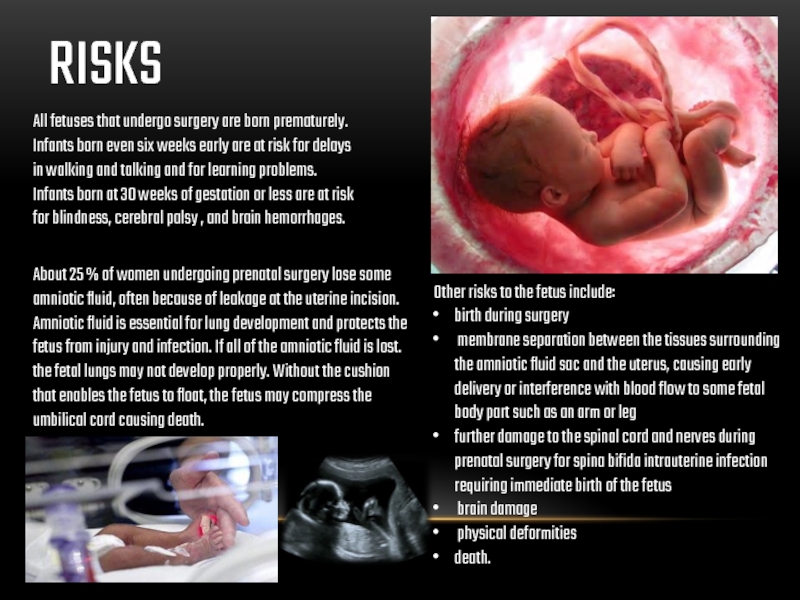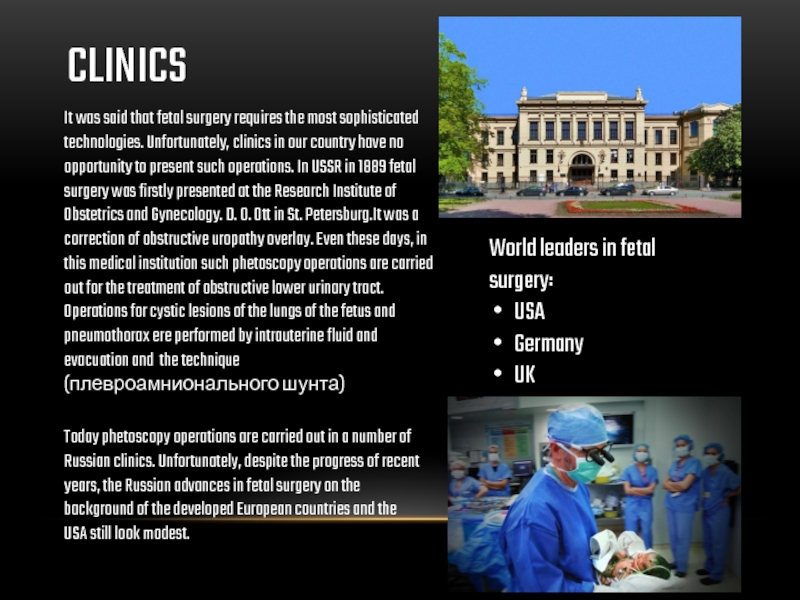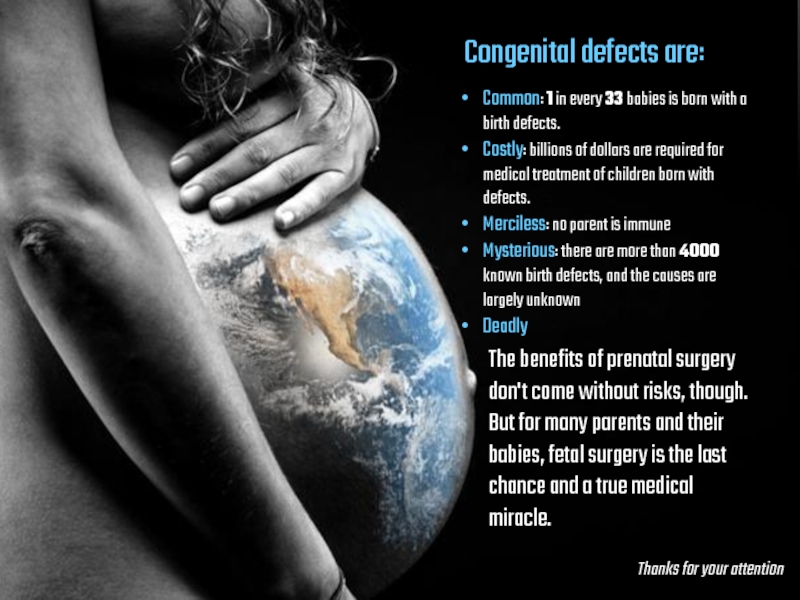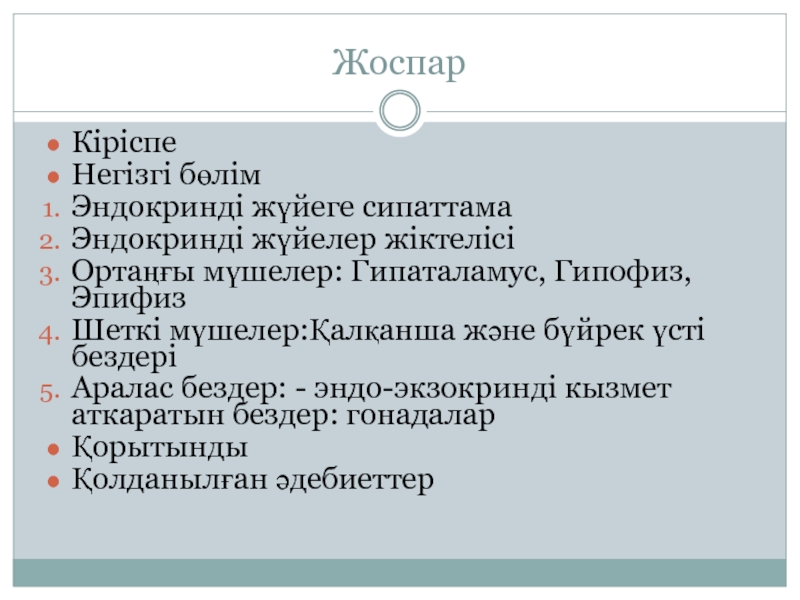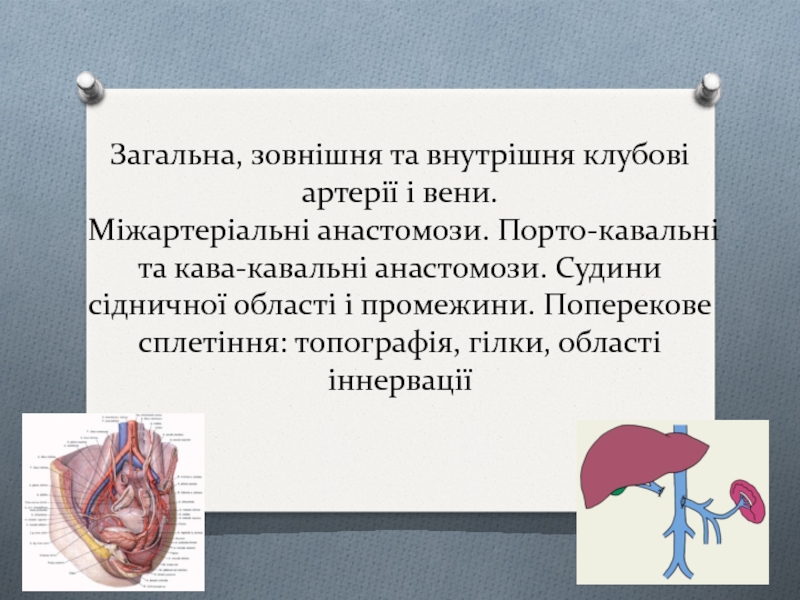- Главная
- Разное
- Дизайн
- Бизнес и предпринимательство
- Аналитика
- Образование
- Развлечения
- Красота и здоровье
- Финансы
- Государство
- Путешествия
- Спорт
- Недвижимость
- Армия
- Графика
- Культурология
- Еда и кулинария
- Лингвистика
- Английский язык
- Астрономия
- Алгебра
- Биология
- География
- Детские презентации
- Информатика
- История
- Литература
- Маркетинг
- Математика
- Медицина
- Менеджмент
- Музыка
- МХК
- Немецкий язык
- ОБЖ
- Обществознание
- Окружающий мир
- Педагогика
- Русский язык
- Технология
- Физика
- Философия
- Химия
- Шаблоны, картинки для презентаций
- Экология
- Экономика
- Юриспруденция
Tinkering in the womb. Fetal surgery презентация
Содержание
- 1. Tinkering in the womb. Fetal surgery
- 2. Tinkering in the womb: fetal surgery
- 3. HOW DOES PRENATAL SURGERY WORK? The most
- 4. OPEN FETAL SURGERY: In this type of
- 5. 1.Open fetal repair for myelomeningocele ( Spina
- 6. Fetal surgery for CDH was originally proposed
- 7. MINIMALLY INVASIVE FETOSCOPIC SURGERY The surgeon makes
- 8. ADVANCES OF FETAL SURGERY Stem cell therapies
- 9. ETHICAL ISSUES When doctors began performing open
- 10. Today fetal reduction, the systematic killing of
- 11. Many mothers are willing to do
- 12. RISKS A major risk of prenatal surgery
- 13. All fetuses that undergo surgery are born
- 14. CLINICS It was said that fetal surgery
- 15. Congenital defects are: Common: 1 in
Слайд 2Tinkering in the womb: fetal surgery
The aim of research:
I based
The actuality:
Unfortunately in our days many diseases become younger and younger .Even unborn child has a risk. For parents it’s immensely hard to understand that the condition of their desired child cannot await therapy until after birth. Fetal surgery allows doctors to intervene earlier. Today, fetal therapy is recognized as one of the most promising fields in pediatric medicine, and prenatal surgery is becoming an option for a growing number of babies with birth defects.
Слайд 3HOW DOES PRENATAL SURGERY WORK?
The most common types are:
Open fetal surgery
Minimally
Fetal image-guided surgery is done without an incision to the uterus or use of an endoscope. Doctors use ultrasound to guide them as they perform "fetal manipulations," such as placing a catheter in the bladder, abdomen, or chest. The least-invasive form of fetal surgery, it's not used for serious conditions that require open surgery.
Operating on a baby before birth may seem like science fiction, but prenatal surgery is becoming more and more common in special pediatric programs.
Слайд 4OPEN FETAL SURGERY:
In this type of procedure, the mother is given
The uterus is opened with a special stapling device that prevents bleeding and membrane separation, the fetus is either partially or completely taken out of the womb, warmed fluids are continuously infused into the uterus to keep the amniotic fluid level safe for the mother and baby. Surgery is done, then the baby is returned to the uterus, and the incision is closed.
Слайд 51.Open fetal repair for myelomeningocele ( Spina bifida)
2.Resection of a chest
3.Resection of a sacrococcygeal teratoma
4.Congenital diaphragmatic hernia (CDH) -?
Open fetal surgery may be used for several conditions:
SPINA BIFIDA
Until the late 1990s, prenatal surgery was almost exclusively limited to life-threatening conditions. However in 1994 the first prenatal surgery to treat spina bifida (myelomeningocele) was performed. This is the second most common birth defect, affecting one out of every 2,000 newborns. It is not considered to be life-threatening.
Spina bifida occurs during the first month of fetal development when a small bit of bone and skin fails to fully enclose the nerves of the spinal cord, leaving a hole or lesion. Surgery for spina bifida requires closing the opening in the cord. Since the damage from spina bifida occurs during fetal development, prenatal surgery may reduce the damage.
Слайд 6Fetal surgery for CDH was originally proposed to involve open fetal
CONGENITAL DIAPHRAGMATIC HERNIA
Babies with CDH have a hole in their diaphragm, allowing organs normally situated in the abdomen to migrate into the chest. These organs take up space meant for the lungs. CDH is rarely fatal in utero, but babies with a severe form of the condition often die after birth as a result of their underdeveloped lungs.
The main challenge for these fetuses was that the liver was herniated into the chest, and, when the liver was reduced back into the abdomen during open fetal repair, the blood flow through the umbilical vein and inferior vena cava became occluded, resulting in death of the fetus. Fetuses without liver herniation typically had sufficient lung development to ensure a relatively good outcome with standard postnatal care.
Reasoning that minimal manipulation of the uterus would help reduce the risk of preterm labor, the technique of fetoscopic tracheal occlusion to promote lung growth was conceived.
?
Слайд 7MINIMALLY INVASIVE FETOSCOPIC SURGERY
The surgeon makes a pencil-tip-sized incision and inserts
Ultrasound technology helps guide the fetoscope throughout the uterus.
Fetoscopic surgery is much less invasive than open fetal surgery, thus decreasing the risk of preterm labor. Mothers are given anesthesia during the procedure to help with pain control and anxiety. The fetus is also given medication to decrease movement and prevent pain.
Surgery is most useful for:
problems with the placenta, such as twin-twin transfusion syndrome in which one identical twin grows at the expense of the other because of abnormal blood vessel connections in the placenta they share.
Bladder and chest shunt placement
Fetoscopic endoluminal tracheal occlusion (FETO) for severe CDH
Fetoscopic laser ablation (LASER)
Bipolar cord coagulation (BCC)
Radio frequency ablation (RFA)
Слайд 8ADVANCES OF FETAL SURGERY
Stem cell therapies hold particular promise, according to
Scientists are investigating the potential of blood-forming stem cells to tame sickle cell anemia, a genetic disease that doctors can already diagnose in utero. They have already proven that injecting blood-forming stem cells in utero can work in large animal models, including sheep and dogs.
Слайд 9ETHICAL ISSUES
When doctors began performing open surgery, in the early 1980s,
Слайд 10Today fetal reduction, the systematic killing of one or more fetuses
ETHICAL ISSUES
In the past, experimental treatments for the seriously ill could be justified on the grounds that the patient had everything to gain and nothing to lose. With fetal surgery, that may hold true for the fetus, of course, but the benefits and risks to the mother are far less obvious.
Слайд 11 Many mothers are willing to do whatever is necessary to
Research studies have shown that fetal surgery does not interfere with a woman's future fertility. Still, ethicists argue that a woman must always have the freedom to choose against fetal surgery. They fear that as the procedures gain acceptance and it proves more successful, women will find it increasingly difficult to say no. They also worry that a judge might order a woman to have fetal surgery against her will. Legal precedent already exists for this kind of dispute between mother and fetus. Pregnant women have been ordered to have unwanted cesarean sections after medical authorities testified that the operation was in the best interest of the unborn baby.
ETHICAL ISSUES
MOTHER
FETUS
?
Слайд 12RISKS
A major risk of prenatal surgery is nicking the placenta, causing
Other risks to the mother include:
extensive blood loss
complications from general anesthesia
side effects, potentially fatal, from medications to control premature labor
rupturing of the uterine incision
infection of the wound or uterus
psychological stress
inability to have additional children death
Слайд 13All fetuses that undergo surgery are born prematurely. Infants born even
RISKS
About 25 % of women undergoing prenatal surgery lose some amniotic fluid, often because of leakage at the uterine incision. Amniotic fluid is essential for lung development and protects the fetus from injury and infection. If all of the amniotic fluid is lost. the fetal lungs may not develop properly. Without the cushion that enables the fetus to float, the fetus may compress the umbilical cord causing death.
Other risks to the fetus include:
birth during surgery
membrane separation between the tissues surrounding the amniotic fluid sac and the uterus, causing early delivery or interference with blood flow to some fetal body part such as an arm or leg
further damage to the spinal cord and nerves during prenatal surgery for spina bifida intrauterine infection requiring immediate birth of the fetus
brain damage
physical deformities
death.
Слайд 14CLINICS
It was said that fetal surgery requires the most sophisticated technologies.
Today phetoscopy operations are carried out in a number of Russian clinics. Unfortunately, despite the progress of recent years, the Russian advances in fetal surgery on the background of the developed European countries and the USA still look modest.
World leaders in fetal surgery:
USA
Germany
UK
Слайд 15Congenital defects are:
Common: 1 in every 33 babies is born with
Costly: billions of dollars are required for medical treatment of children born with defects.
Merciless: no parent is immune
Mysterious: there are more than 4000 known birth defects, and the causes are largely unknown
Deadly
The benefits of prenatal surgery don't come without risks, though. But for many parents and their babies, fetal surgery is the last chance and a true medical miracle.
Thanks for your attention
